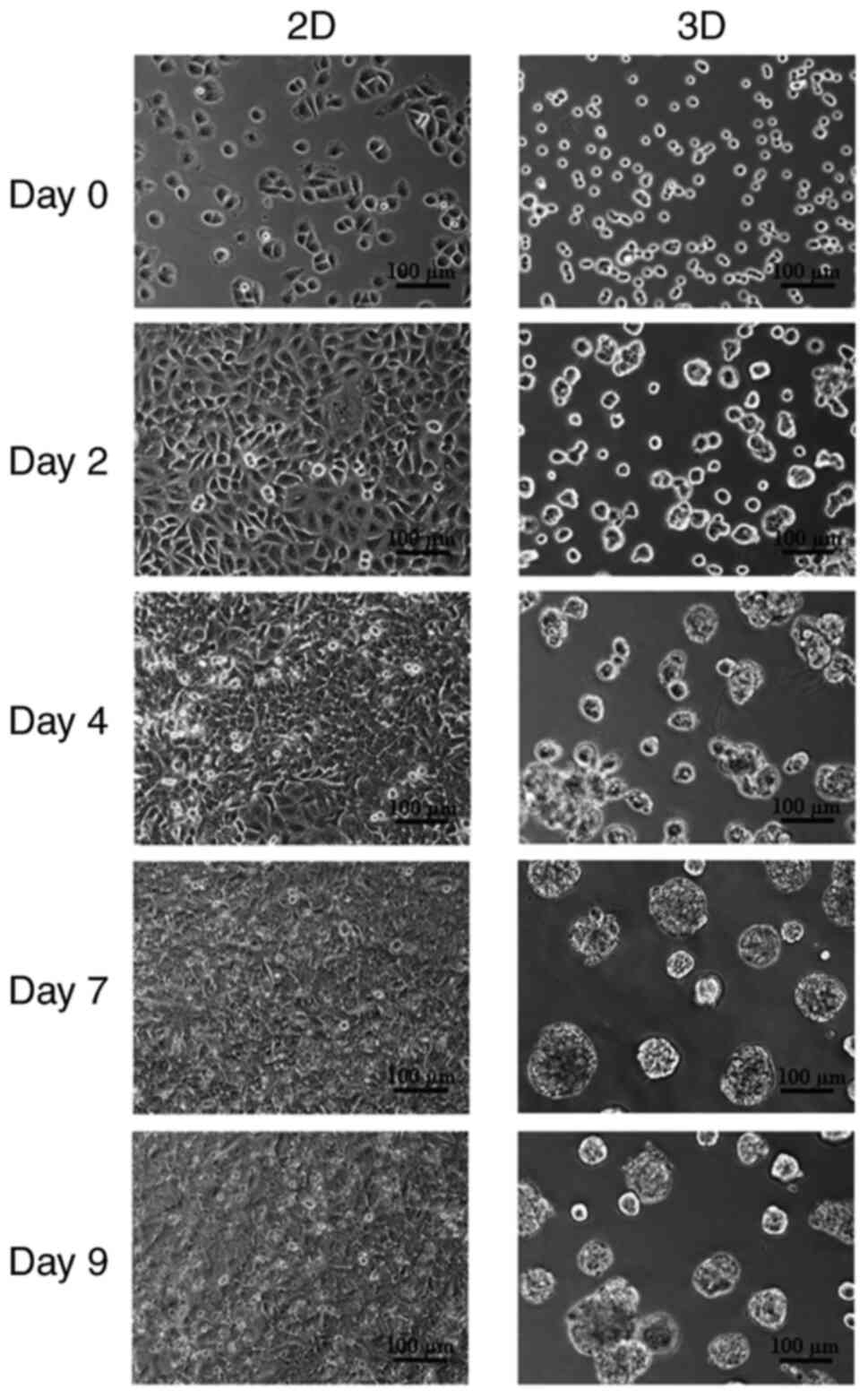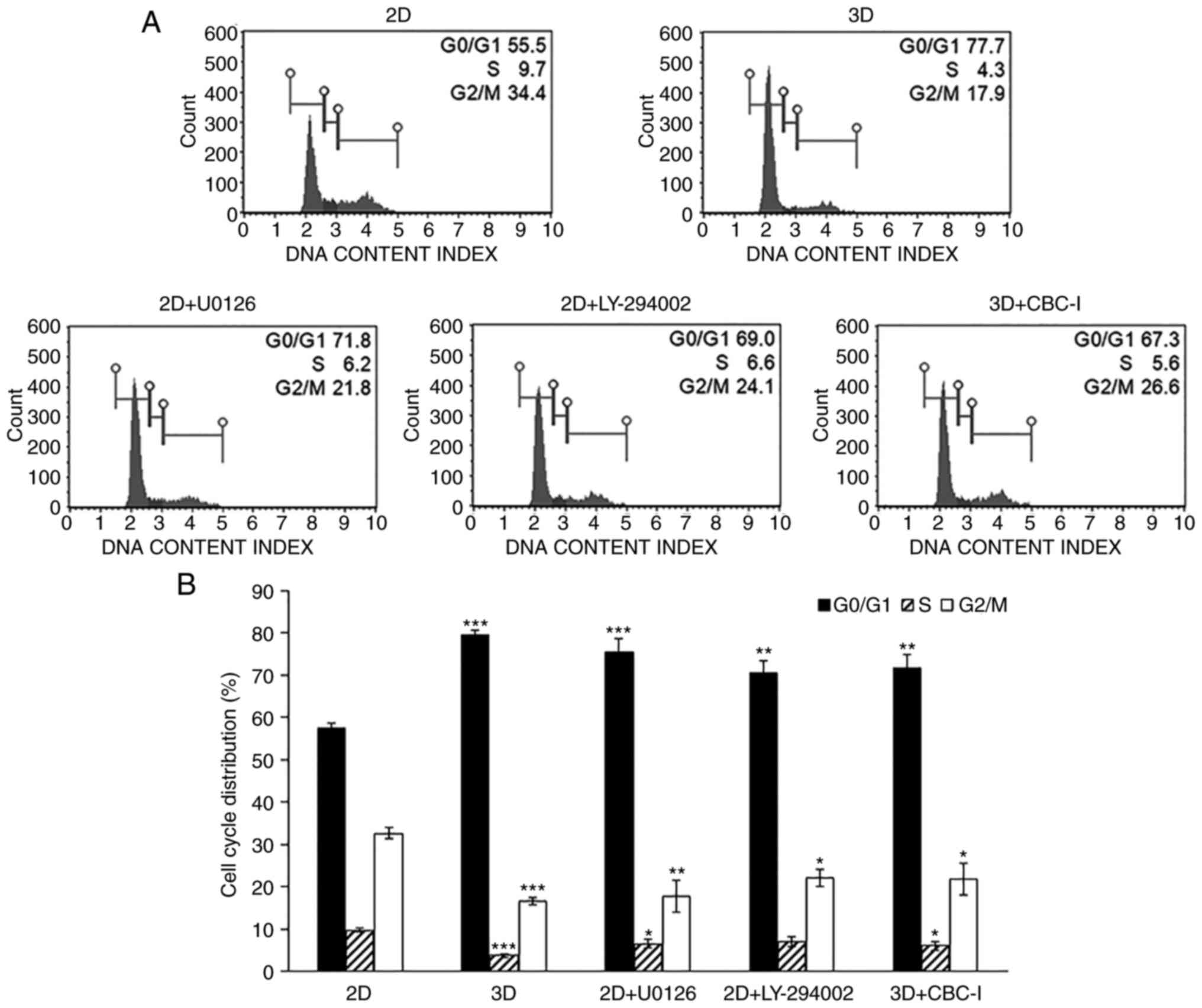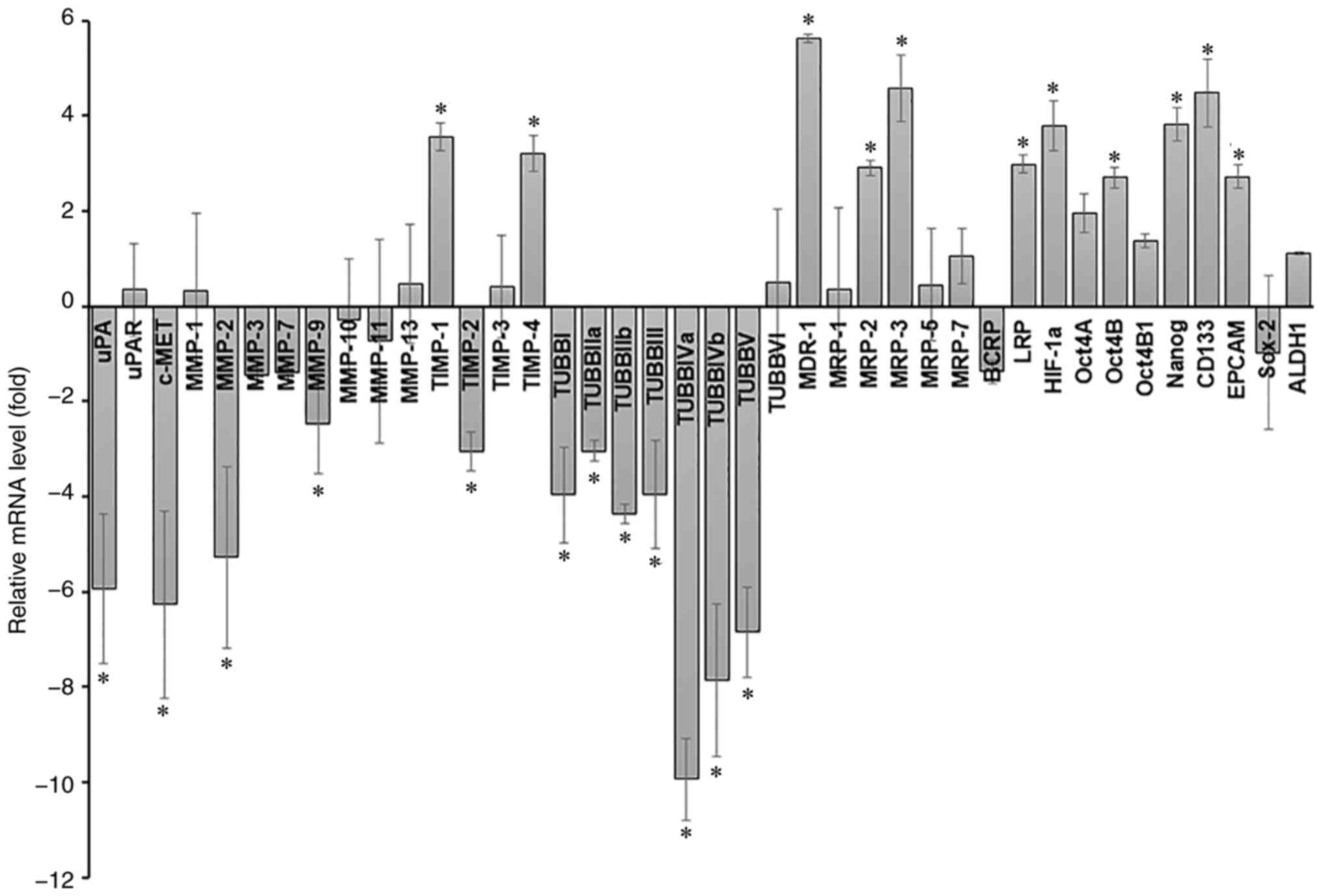|
1
|
Sung H, Ferlay J, Siegel RL, Laversanne M,
Soerjomataram I, Jemal A and Bray F: Global cancer statistics 2020:
GLOBOCAN estimates of incidence and mortality worldwide for 36
cancers in 185 countries. CA Cancer J Clin. 71:209–249. 2021.
View Article : Google Scholar : PubMed/NCBI
|
|
2
|
World Health Organization (WHO), . Cancer.
WHO; Geneva: 2022, https://www.who.int/news-room/fact-sheets/detail/cancerFebruary
3–2022
|
|
3
|
Jemal A, Siegel R, Ward E, Hao Y, Xu J and
Thun MJ: Cancer statistics, 2009. CA Cancer J Clin. 59:225–249.
2009. View Article : Google Scholar : PubMed/NCBI
|
|
4
|
Savage P, Stebbing J, Bower M and Crook T:
Why does cytotoxic chemotherapy cure only some cancers? Nat Clin
Pract Oncol. 6:43–52. 2009. View Article : Google Scholar : PubMed/NCBI
|
|
5
|
Mansoori B, Mohammadi A, Davudian S,
Shirjang S and Baradaran B: The different mechanisms of cancer drug
resistance: A brief review. Adv Pharm Bull. 7:339–348. 2017.
View Article : Google Scholar : PubMed/NCBI
|
|
6
|
Аrtykov АА, Belov DA, Shipunova VO,
Trushina DB, Deyev SM, Dolgikh DA, Kirpichnikov MP and Gasparian
ME: Chemotherapeutic agents sensitize resistant cancer cells to the
DR5-specific variant DR5-B more efficiently than to TRAIL by
modulating the surface expression of death and decoy receptors.
Cancers (Basel). 12:11292020. View Article : Google Scholar
|
|
7
|
Kim YH, Shin EA, Jung JH, Park JE, Koo J,
Koo JI, Shim BS and Kim SH: Galbanic acid potentiates TRAIL induced
apoptosis in resistant non-small cell lung cancer cells via
inhibition of MDR1 and activation of caspases and DR5. Eur J
Pharmacol. 847:91–96. 2019. View Article : Google Scholar : PubMed/NCBI
|
|
8
|
Kim MS, Haney MJ, Zhao Y, Mahajan V,
Deygen I, Klyachko NL, Inskoe E, Piroyan A, Sokolsky M, Okolie O,
et al: Development of exosome-encapsulated paclitaxel to overcome
MDR in cancer cells. Nanomedicine. 12:655–664. 2016. View Article : Google Scholar : PubMed/NCBI
|
|
9
|
Weaver VM, Fischer AH, Peterson OW and
Bissell MJ: The importance of the microenvironment in breast cancer
progression: Recapitulation of mammary tumorigenesis using a unique
human mammary epithelial cell model and a three-dimensional culture
assay. Biochem Cell Biol. 74:833–851. 1996. View Article : Google Scholar : PubMed/NCBI
|
|
10
|
Hanahan D: Hallmarks of cancer: New
dimensions. Cancer Discov. 12:31–46. 2022. View Article : Google Scholar : PubMed/NCBI
|
|
11
|
Hanahan D and Coussens LM: Accessories to
the crime: Functions of cells recruited to the tumor
microenvironment. Cancer Cell. 21:309–322. 2012. View Article : Google Scholar : PubMed/NCBI
|
|
12
|
Bhadriraju K and Chen CS: Engineering
cellular microenvironments to improve cell-based drug testing. Drug
Discov Today. 7:612–620. 2002. View Article : Google Scholar : PubMed/NCBI
|
|
13
|
Ashworth A, Balkwill F, Bast RC, Berek JS,
Kaye A, Boyd JA, Mills G, Weinstein JN, Woolley K and Workman P:
Opportunities and challenges in ovarian cancer research, a
perspective from the 11th Ovarian cancer action/HHMT Forum, Lake
Como, March 2007. Gynecol Oncol. 108:652–657. 2008. View Article : Google Scholar : PubMed/NCBI
|
|
14
|
Gurski LA, Petrelli NJ, Jia X and
Farach-Carson MC: 3D matrices for anti-cancer drug testing and
development. Oncol Issues. 25:20–25. 2010. View Article : Google Scholar
|
|
15
|
Baharvand H, Hashemi SM, Kazemi Ashtiani S
and Farrokhi A: Differentiation of human embryonic stem cells into
hepatocytes in 2D and 3D culture systems in vitro. Int J Dev Biol.
50:645–652. 2006. View Article : Google Scholar : PubMed/NCBI
|
|
16
|
Amann A, Gamerith G, Huber JM, Zwierzina
M, Hilbe W and Zwierzina H: Predicting drug sensitivity by 3D cell
culture models. Memo. 8:77–80. 2015. View Article : Google Scholar
|
|
17
|
Huber JM, Amann A, Koeck S, Lorenz E, Kelm
JM, Obexer P, Zwierzina H and Gamerith G: Evaluation of assays for
drug efficacy in a three-dimensional model of the lung. J Cancer
Res Clin. 142:1955–1966. 2016. View Article : Google Scholar : PubMed/NCBI
|
|
18
|
Takahashi Y, Hori Y, Yamamoto T, Urashima
T, Ohara Y and Tanaka H: 3D spheroid cultures improve the metabolic
gene expression profiles of HepaRG cells. Biosci Rep.
35:e002082015. View Article : Google Scholar : PubMed/NCBI
|
|
19
|
Wiśniewski JR, Vildhede A, Norén A and
Artursson P: In-depth quantitative analysis and comparison of the
human hepatocyte and hepatoma cell line HepG2 proteomes. J
Proteomics. 136:234–247. 2016. View Article : Google Scholar : PubMed/NCBI
|
|
20
|
Lee GY, Kenny PA, Lee EH and Bissell MJ:
Three-dimensional culture models of normal and malignant breast
epithelial cells. Nat Methods. 4:359–365. 2007. View Article : Google Scholar : PubMed/NCBI
|
|
21
|
Keeratichamroen S, Lirdprapamongkol K,
Thongnest S, Boonsombat J, Chawengrum P, Sornprachum T, Sirirak J,
Verathamjamras C, Ornnork N, Ruchirawat S and Svasti J:
JAK2/STAT3-mediated dose-dependent cytostatic and cytotoxic effects
of sesquiterpene lactones from Gymnanthemum extensum on A549 human
lung carcinoma cells. Oncol Rep. 47:62022. View Article : Google Scholar : PubMed/NCBI
|
|
22
|
Keeratichamroen S, Lirdprapamongkol K and
Svasti J: Mechanism of ECM-induced dormancy and chemoresistance in
A549 human lung carcinoma cells. Oncol Rep. 39:1765–1774.
2018.PubMed/NCBI
|
|
23
|
Livak KJ and Schmittgen TD: Analysis of
relative gene expression data using real-time quantitative PCR and
the 2(−Delta Delta C(T)) method. Methods. 25:402–408. 2001.
View Article : Google Scholar : PubMed/NCBI
|
|
24
|
Khaitan D, Chandna S, Arya MB and
Dwarakanath BS: Establishment and characterization of multicellular
spheroids from a human glioma cell line; implications for tumor
therapy. J Transl Med. 4:122006. View Article : Google Scholar : PubMed/NCBI
|
|
25
|
Mehta G, Hsiao AY, Ingram M, Luker GD and
Takayama S: Opportunities and challenges for use of tumor spheroids
as models to test drug delivery and efficacy. J Control Release.
164:192–204. 2012. View Article : Google Scholar : PubMed/NCBI
|
|
26
|
Wang Z, Mai S, Lv P, Xu L and Wang Y:
Etoposide plus cisplatin chemotherapy improves the efficacy and
safety of small cell lung cancer. Am J Transl Res. 13:12825–12833.
2021.PubMed/NCBI
|
|
27
|
Olmedo ME, Forster M, Moreno V,
López-Criado MP, Braña I, Flynn M, Doger B, de Miguel M,
López-Vilariño JA, Núñez R, et al: Efficacy and safety of
lurbinectedin and doxorubicin in relapsed small cell lung cancer.
Results from an expansion cohort of a phase I study. Invest New
Drugs. 39:1275–1283. 2021. View Article : Google Scholar : PubMed/NCBI
|
|
28
|
Cacaccio JC, Durrani FA, Missert JR and
Pandey RK: Photodynamic therapy in combination with doxorubicin is
superior to monotherapy for the treatment of lung cancer.
Biomedicines. 10:8572022. View Article : Google Scholar : PubMed/NCBI
|
|
29
|
Gomez-Roman N, Stevenson K, Gilmour L,
Hamilton G and Chalmers AJ: A novel 3D human glioblastoma cell
culture system for modeling drug and radiation responses. Neuro
Oncol. 19:229–241. 2017.PubMed/NCBI
|
|
30
|
Aljitawi OS, Li D, Xiao Y, Zhang D,
Ramachandran K, Stehno-Bittel L, Van Veldhuizen P, Lin TL,
Kambhampati S and Garimella R: A novel three-dimensional
stromal-based model for in vitro chemotherapy sensitivity testing
of leukemia cells. Leuk Lymphoma. 55:378–391. 2014. View Article : Google Scholar : PubMed/NCBI
|
|
31
|
Kola I: The state of innovation in drug
development. Clin Pharmacol Ther. 83:227–230. 2008. View Article : Google Scholar : PubMed/NCBI
|
|
32
|
Zanoni M, Piccinini F, Arienti C, Zamagni
A, Santi S, Polico R, Bevilacqua A and Tesei A: 3D tumor spheroid
models for in vitro therapeutic screening: A systematic approach to
enhance the biological relevance of data obtained. Sci Rep.
6:191032016. View Article : Google Scholar : PubMed/NCBI
|
|
33
|
Giannattasio A, Weil S, Kloess S, Ansari
N, Stelzer EH, Cerwenka A, Steinle A, Koehl U and Koch J:
Cytotoxicity and infiltration of human NK cells in in vivo-like
tumor spheroids. BMC Cancer. 15:3512015. View Article : Google Scholar : PubMed/NCBI
|
|
34
|
Lee JM, Mhawech-Fauceglia P, Lee N,
Parsanian LC, Lin YG, Gayther SA and Lawrenson K: A
three-dimensional microenvironment alters protein expression and
chemosensitivity of epithelial ovarian cancer cells in vitro. Lab
Invest. 93:528–542. 2013. View Article : Google Scholar : PubMed/NCBI
|
|
35
|
Edmondson R, Broglie JJ, Adcock AF and
Yang L: Three-dimensional cell culture systems and their
applications in drug discovery and cell-based biosensors. Assay
Drug Dev Technol. 12:207–218. 2014. View Article : Google Scholar : PubMed/NCBI
|
|
36
|
Riffle S and Hegde RS: Modeling tumor cell
adaptations to hypoxia in multicellular tumor spheroids. J Exp Clin
Cancer Res. 36:1022017. View Article : Google Scholar : PubMed/NCBI
|
|
37
|
Mishra DK, Sakamoto JH, Thrall MJ, Baird
BN, Blackmon SH, Ferrari M, Kurie JM and Kim MP: Human lung cancer
cells grown in an ex vivo 3D lung model produce matrix
metalloproteinases not produced in 2D culture. PLoS One.
7:e453082012. View Article : Google Scholar : PubMed/NCBI
|
|
38
|
Walenta S, Dötsch J, Bourrat-Flöck B and
Mueller-Klieser W: Size-dependent oxygenation and energy status in
multicellular tumor spheroids. Adv Exp Med Biol. 277:889–893. 1990.
View Article : Google Scholar : PubMed/NCBI
|
|
39
|
Topacio BR, Zatulovskiy E, Cristea S, Xie
S, Tambo CS, Rubin SM, Sage J, Kõivomägi M and Skotheim JM: Cyclin
D-Cdk4,6 drives cell-cycle progression via the retinoblastoma
protein's C-terminal helix. Mol Cell. 74:758–770.e4. 2019.
View Article : Google Scholar : PubMed/NCBI
|
|
40
|
Aguirre-Ghiso JA, Estrada Y, Liu D and
Ossowski L: ERK(MAPK) activity as a determinant of tumor growth and
dormancy; regulation by p38(SAPK). Cancer Res. 63:1684–1695.
2003.PubMed/NCBI
|
|
41
|
Kanojia D, Morshed RA, Zhang L, Miska JM,
Qiao J, Kim JW, Pytel P, Balyasnikova IV, Lesniak MS and Ahmed AU:
βIII-tubulin regulates breast cancer metastases to the brain. Mol
Cancer Ther. 14:1152–1161. 2015. View Article : Google Scholar : PubMed/NCBI
|
|
42
|
Duffy MJ: The urokinase plasminogen
activator system: Role in malignancy. Curr Pharm Des. 10:39–49.
2004. View Article : Google Scholar : PubMed/NCBI
|
|
43
|
Nan L, Qin T, Xiao Y, Qian W, Li J, Wang
Z, Ma J, Ma Q and Wu Z: Pancreatic stellate cells facilitate
perineural invasion of pancreatic cancer via HGF/c-Met pathway.
Cell Transplant. 28:1289–1298. 2019. View Article : Google Scholar : PubMed/NCBI
|
|
44
|
Lim YC, Han JH, Kang HJ, Kim YS, Lee BH,
Choi EC and Kim CH: Overexpression of c-Met promotes invasion and
metastasis of small oral tongue carcinoma. Oral Oncol.
48:1114–1119. 2012. View Article : Google Scholar : PubMed/NCBI
|
|
45
|
Hernandez-Barrantes S, Shimura Y, Soloway
PD, Sang QA and Fridman R: Differential roles of TIMP-4 and TIMP-2
in pro-MMP-2 activation by MT1-MMP. Biochem Biophys Res Commun.
281:126–130. 2001. View Article : Google Scholar : PubMed/NCBI
|
|
46
|
Lu KH, Chen YW, Tsai PH, Tsai ML, Lee YY,
Chiang CY, Kao CL, Chiou SH, Ku HH, Lin CH and Chen YJ: Evaluation
of radiotherapy effect in resveratrol-treated medulloblastoma
cancer stem-like cells. Childs Nerv Syst. 25:543–550. 2009.
View Article : Google Scholar : PubMed/NCBI
|
|
47
|
Talukdar S, Bhoopathi P, Emdad L, Das S,
Sarkar D and Fisher PB: Dormancy and cancer stem cells: An enigma
for cancer therapeutic targeting. Adv Cancer Res. 141:43–84. 2019.
View Article : Google Scholar : PubMed/NCBI
|
|
48
|
Arai F and Suda T: Maintenance of
quiescent hematopoietic stem cells in the osteoblastic niche. Ann N
Y Acad Sci. 1106:41–53. 2007. View Article : Google Scholar : PubMed/NCBI
|
|
49
|
Olive PL and Durand RE: Drug and radiation
resistance in spheroids: Cell contact and kinetics. Cancer
Metastasis Rev. 13:121–138. 1994. View Article : Google Scholar : PubMed/NCBI
|
|
50
|
Fardel O, Payen L, Courtois A, Vernhet L
and Lecureur V: Regulation of biliary drug efflux pump expression
by hormones and xenobiotics. Toxicology. 167:37–46. 2001.
View Article : Google Scholar : PubMed/NCBI
|
|
51
|
Korita PV, Wakai T, Shirai Y, Matsuda Y,
Sakata J, Takamura M, Yano M, Sanpei A, Aoyagi Y, Hatakeyama K and
Ajioka Y: Multidrug resistance-associated protein 2 determines the
efficacy of cisplatin in patients with hepatocellular carcinoma.
Oncol Rep. 23:965–972. 2010.PubMed/NCBI
|
|
52
|
Pirker R, Pohl G, Stranzl T, Suchomel RW,
Scheper RJ, Jäger U, Geissler K, Lechner K and Filipits M: The lung
resistance protein (LRP) predicts poor outcome in acute myeloid
leukemia. Adv Exp Med Biol. 457:133–139. 1999. View Article : Google Scholar : PubMed/NCBI
|
|
53
|
Miyoshi S, Hamada H, Hamaguchi N, Kato A,
Katayama H, Irifune K, Ito R, Miyazaki T, Okura T and Higaki J:
Antitumor activity of MEK and PI3K inhibitors against malignant
pleural mesothelioma cells in vitro and in vivo. Int
J Oncol. 41:449–456. 2012. View Article : Google Scholar : PubMed/NCBI
|
|
54
|
Resemann HK, Watson CJ and Lloyd-Lewis B:
The Stat3 paradox: A killer and an oncogene. Mol Cell Endocrinol.
382:603–611. 2014. View Article : Google Scholar : PubMed/NCBI
|
|
55
|
Ham IH, Wang L, Lee D, Woo J, Kim TH,
Jeong HY, Oh HJ, Choi KS, Kim TM and Hur H: Curcumin inhibits the
cancer-associated fibroblast-derived chemoresistance of gastric
cancer through the suppression of the JAK/STAT3 signaling pathway.
Int J Oncol. 61:852022. View Article : Google Scholar : PubMed/NCBI
|
|
56
|
Seo HS, Ku JM, Choi HS, Woo JK, Lee BH,
Kim DS, Song HJ, Jang BH, Shin YC and Ko SG: Apigenin overcomes
drug resistance by blocking the signal transducer and activator of
transcription 3 signaling in breast cancer cells. Oncol Rep.
38:715–724. 2017. View Article : Google Scholar : PubMed/NCBI
|
|
57
|
Shen M, Xu Z, Xu W, Jiang K, Zhang F, Ding
Q, Xu Z and Chen Y: Inhibition of ATM reverses EMT and decreases
metastatic potential of cisplatin-resistant lung cancer cells
through JAK/STAT3/PD-L1 pathway. J Exp Clin Cancer Res. 38:1492019.
View Article : Google Scholar : PubMed/NCBI
|
|
58
|
Ying L, Zhu Z, Xu Z, He T, Li E, Guo Z,
Liu F, Jiang C and Wang Q: Cancer associated fibroblast-derived
hepatocyte growth factor inhibits the paclitaxel-induced apoptosis
of lung cancer a549 cells by up-regulating the PI3K/Akt and GRP78
signaling on a microfluidic platform. PLoS One. 10:e01295932015.
View Article : Google Scholar : PubMed/NCBI
|
|
59
|
Eguchi H, Akizuki R, Maruhashi R,
Tsukimoto M, Furuta T, Matsunaga T, Endo S and Ikari A: Increase in
resistance to anticancer drugs involves occludin in spheroid
culture model of lung adenocarcinoma A549 cells. Sci Rep.
8:151572018. View Article : Google Scholar : PubMed/NCBI
|
|
60
|
Archilla-Ortega A, Domuro C,
Martin-Liberal J and Muñoz P: Blockade of novel immune checkpoints
and new therapeutic combinations to boost antitumor immunity. J Exp
Clin Cancer Res. 41:622022. View Article : Google Scholar : PubMed/NCBI
|
|
61
|
Liu XD, Hoang A, Zhou L, Kalra S, Yetil A,
Sun M, Ding Z, Zhang X, Bai S, German P, et al: Resistance to
antiangiogenic therapy is associated with an immunosuppressive
tumor microenvironment in metastatic renal cell carcinoma. Cancer
Immunol Res. 3:1017–1029. 2015. View Article : Google Scholar : PubMed/NCBI
|
|
62
|
Kohlhapp FJ, Haribhai D, Mathew R, Duggan
R, Ellis PA, Wang R, Lasater EA, Shi Y, Dave N, Riehm JJ, et al:
Venetoclax increases intratumoral effector T cells and antitumor
efficacy in combination with immune checkpoint blockade. Cancer
Discov. 11:68–79. 2021. View Article : Google Scholar : PubMed/NCBI
|
















